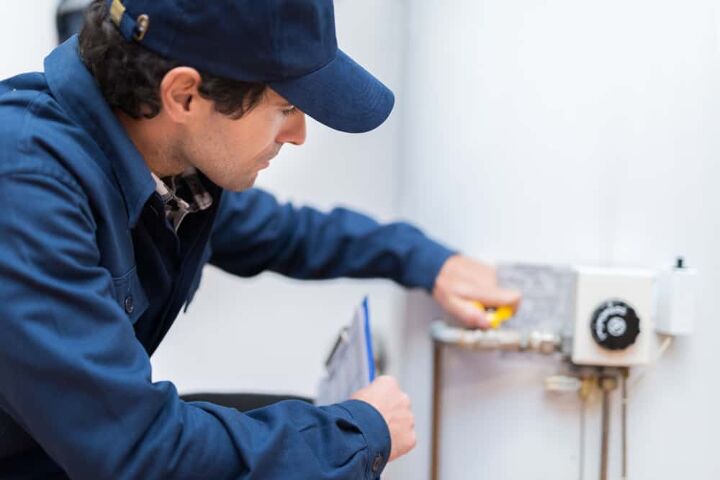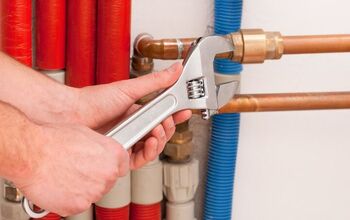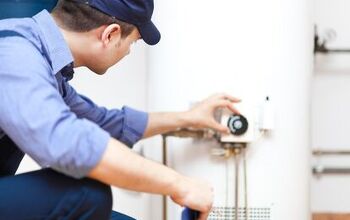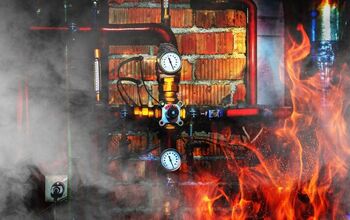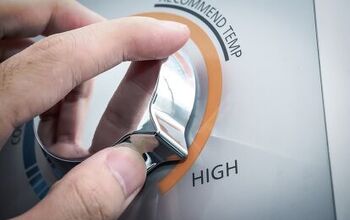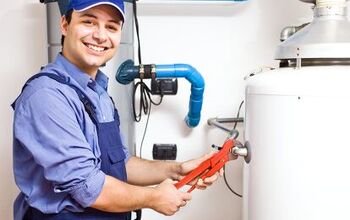Water Heater Making Hissing Sounds? (Possible Causes & Fixes)

Water heaters can make all kinds of noises when something is damaged or not running properly. However, if you suddenly start hearing a hissing noise coming from your water heater, you may want to take care of it soon. A hissing sound may not be dangerous to you and your family, but it can eventually damage the water heater.
The most common issues when you hear your water heater hissing are the temperature and the pressure valve. The pressure valve is a valve that opens automatically when the pressure inside the tank increases. The hotter the water heater, the more the pressure builds up.
If the pressure is building up with no release, it can cause further damage. You need to replace the pressure valve in order to stop this from becoming a more problematic issue. Also, some types of leaks and tank fractures might cause hissing sounds.
Do You Need Water Heater Repair Services?
Get free, zero-commitment quotes from pro contractors near you.

Testing Your Pressure Valve
If you want to verify that the pressure valve is the issue, you can try a simple test. First, place your hand on the overflow pipe leading away from the valve to determine whether the line is hot. There should be some warmth to the line; however, if the line is actually hot, then the valve is faulty.
Preparing to Replace the Pressure Valve
Before you do any kind of work to a water heater, you should always turn off the circuit breaker. You can also turn it to the pilot setting, but turning it off is more reliable. Leaving the tank on when you need to drain it may cause further damage or injuries to anybody around it.
Tools Needed For The Job
- Large adjustable wrench
- Extra towels for cleaning excess water
- A bucket
- Water hose
Step One: Turn off the Water Inlet, and Turn on the Hot Water Faucet
Turn off the cold water inlet valve that brings water into the water heater. Then, turn on the hot water faucet closest to the tank. Wait for a bit and allow the pressure to release.
A good thing to keep in mind would be to attach a water hose to the drain outlet. Let the water heater drain, and clean the water heater while it is shut down.
Step Two: Disconnect the Overflow Line
You will need to disconnect the overflow line. Additionally, you should use the overflow drain to drain the water heater later. The overflow line leads away from the pressure valve. In order to do this, you will need to cut the pipe. Ensure that you have some old towels handy to clean up any water that will leak out from the pipe. Alternatively, you can also use a bucket to catch any water that is inside of the pipe.
Using a large adjustable wrench, unscrew the overflow pipe from the pressure valve. This will leave the drain pipe open so that you can attach the water hose to it.
Replace the Pressure Valve
It is essential to choose a replacement valve with the same size pipe. In order to ensure that you receive the correct size, take the pipe to the hardware store with you. The pipe can range anywhere from $20 to $40, depending on size and quality.
Tools You Need for the Job
- Plumbers tape. You can typically find this at any home improvement store for about $4.
- A new pressure valve
- Couplings. You can also find these at any home improvement store for about $4.
- Pipe cement. You can purchase the necessary cement at Walmart or Lowe’s for about $10 to $15.
- Adjustable wrench
Step One: Wrap the Threads with Plumbers Tape
Use plumbers tape to wrap the threads of the new pressure valve. Screw the new valve into the tank until you can’t turn it anymore. Then use a wrench to tighten it until the outlet is facing toward the overflow drain pipe.
Step Two: Reconnecting the Drain Pipe
If the pipe is plastic, you can splice the cut pieces using a coupling and cement. You want to make sure you use the proper amount of cement, so follow the instructions carefully. The cement will need an hour at the least to dry completely.
For metal pipes, there are compression couplings available. The compression couplings will join to a straight edge pipe. However, you can also convert from metal to plastic pipes.
Step Three: Refill the Tank
Start by turning off the hot water faucet that you turned on earlier. Then turn on the cold water inlet valve and let the tank refill. An average size tank should refill in about 20 minutes.
Observe the pipe to make sure that there are no leaks. If there are, you may need to redo some of the steps to tighten the pipe. Reopen the hot water faucet and allow it to run until all of the air has drained from the tank. Finally, shut off the tap.
Step Four: Restore Power
Restore power, or set the valve to the normal operation settings. Be sure to set the thermostat to the desired temperature, or you may end up with scalding hot water. Typically, you should set your water heater to 120 degrees Fahrenheit. Give the water at least one hour to reheat, and then try out the same test you did earlier. Note: In a 40 to 50-gallon tank, the water could take two to three hours to heat thoroughly.
Now that you have replaced the pressure valve, you should no longer hear a hissing noise throughout your home. Everyone will be able to get back to their normal activities with no interruption. Do not forget to clean around the water heater every few weeks to prevent the sediment from building up.
If the water heater is still making a hissing sound, it could be condensation touching hot surfaces. Do not worry; it is not complicated to wipe off the condensation. It’s as simple as letting the water heater cool down and wiping off the tank with a towel.
Other Possible Causes of Hissing Water Heater
If you’ve determined that the pressure valve is not the cause of the mysterious hissing sounds, other potential reasons are as follows:
1. Condensation
Another common reason that a water heater will make a hissing noise is that condensation is coming in contact with a hot surface. You will be able to tell by taking a hot shower or running a dishwasher. If the condensation is the problem, then these will be the only times the water heater hisses.
When the water level in the water heater tank drops, it will fill back up with cold water. This will create condensation on the outside of the tank. The condensation rolls down the tank and comes in contact with a hot surface, causing the hissing sounds.
To fix this, start by cutting the power to the water heater or setting the valve to the pilot setting. The water heater will need about an hour, or a little longer, to cool down so that you can touch it. Once the water heater has cooled down enough to touch, wipe the condensation from around the water heater. This will prevent the hissing sound.
After you have done that, you may restart the water heater. Once again, you will need to give the water heater the proper amount of time to reach the correct temperature.
2. Leak in the Tank
If your water heating hissing is happening throughout the day, and not just after it get emptied, there may a much larger problem. There may be crack in your tank that is causing water to leak out and result in hissing sounds in much of the same manner as condensation does. The sound occurs when the water comes into contact with the tank’s hot surface.
To determine if this is the problem, understand when the hissing is happening. If you notice the sounds at all different times and not just when it’s being refilled, there is likely a leak. Also, inspect for water escaping from the tank. You may notice a puddle forming at the bottom of the tank or moisture trickling down the outside.
If your tank is leaking, it’s important that you get it repaired immediately. Otherwise, the leak will get worse and may cause the tank to burst. Unfortunately, this problem is relatively common with older water heaters.
3. Sediment Build Up
Another potential cause that your hot water heater may be hissing is sediment build up in the tank. Though, if this is the problem, you’ll hear much more than hissing. Oftentimes, the hissing sounds are accompanied by popping noises inside of the tank.
This problem essentially occurs when sediments collects at the base of the tank. All of the minerals present in the water bind together and gather on the tank’s floor. As time goes on, more minerals will settle and the layer will get thicker and thicker. With a thick layer of sediment, water bubbles become trapped and turn into steam, causing the hissing and popping sounds.
This issue is much more common in areas with hard water and to resolve it, you need to consult a professional. They will be able to tell you if a flush can correct the build up or if you’ll need to replace the entire water heater.
Do You Need Water Heater Repair Services?
Get free, zero-commitment quotes from pro contractors near you.

Related Questions
What if my water heater is hissing and has sparks?
If the water heater is hissing and has sparks coming from it, this is a serious issue. Your water heater should never shoot out sparks or steam. If you see either, shut off the water heater immediately.Vacate the home, and call your gas company and a plumber for further instructions. They will need to be informed of the issue so they can come out and fix it properly, with nobody getting hurt.
Why is my water heater making a sizzling sound?
If your water heater is making a sizzling sound, there could be a leak somewhere. You may also notice that you do not have hot water, or there may be water around the water heater. These are all signs of a water leak, where the water is falling onto a hot surface. There could also potentially be a fracture somewhere in the water heater tank. It’s important to address any potential leak as soon as possible. To play things safe, shut off the water and let your tank cool. Then, drain the tank and call in a pro to assess the situation. This way, you won’t end up with a tank full of water flooding your house.
Why does my water heater make a humming noise?
A humming sound simply means that the water heater element is loose. The water flowing around the element is causing a vibration that sounds like a humming noise. To remedy this situation, you need to shut off the power to the tank. Then, turn off the water to the tank, drain the tank, and let it cool. Tighten the heating element inside of the tank. Once you turn everything back on, you can check for any more noise.

Stacy Randall is a wife, mother, and freelance writer from NOLA that has always had a love for DIY projects, home organization, and making spaces beautiful. Together with her husband, she has been spending the last several years lovingly renovating her grandparent's former home, making it their own and learning a lot about life along the way.
More by Stacy Randall



